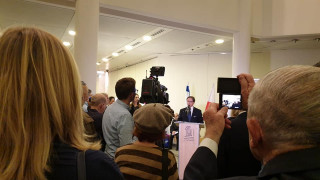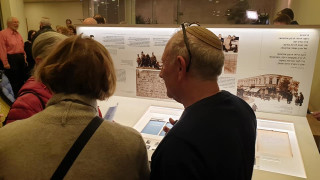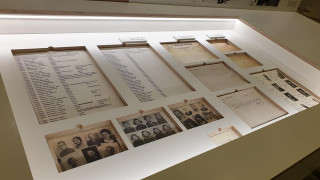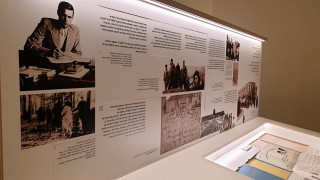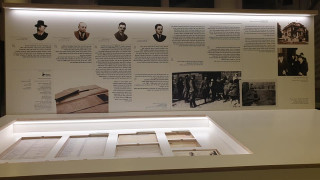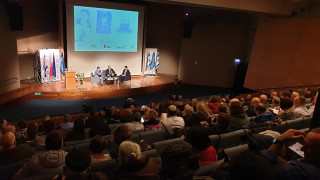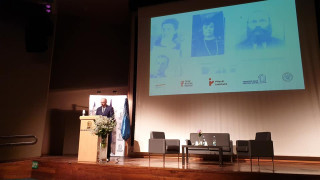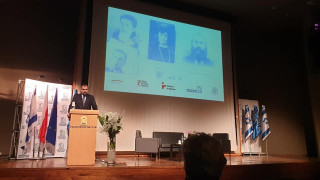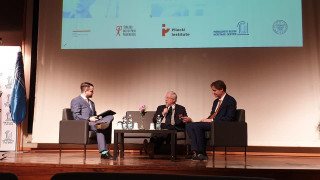The Premiere of the “Passports to Life” Exhibition in Israel - Instytut Pileckiego
The Premiere of the “Passports to Life” Exhibition in Israel
Acting in cooperation with the Polish Institute in Tel Aviv, the Pilecki Institute organized an exhibition entitled “Passports to Life” about the group headed by Aleksander Ładoś. The exposition can be viewed at the Menachem Begin Heritage Center.
It comprises reproductions of passports, documents, photographs, letters and other correspondence from the Chaim Eiss Archive. These document copies were made from originals which are held in the archives of the Auschwitz-Birkenau State Museum.
– The exhibition in Jerusalem, along with our most recent publication, will allow us to present the scale of activities of the so-called Ładoś Group, which remains relatively unknown. The Group itself was made up of Polish diplomats based in Switzerland who conducted a secret operation which succeeded in saving the lives of thousands of Jews – sentenced to perish in the Nazi Holocaust that engulfed the countries of occupied Europe, among them Poland. Purchases were made of original empty forms issued by certain Latin American states, which were then falsified at the Legation of the Republic of Poland in Bern. The ready passports were smuggled to various locations, including ghettos, to buy time and improve chances of survival for people who would otherwise have assuredly been murdered in the German death camps – said Eryk Habowski, the Chief Expert of the Pilecki Institute.
The opening of the exhibition, which took place on Sunday, 15 December, was attended by, among others, Marek Magierowski – the Ambassador of the Republic of Poland to Israel, Jakub Kumoch – the Ambassador of the Republic of Poland to Switzerland, Markus Blechner – the Honorary Consul of the Republic of Poland in Zurich, Herzl Makov – the Director of the Menachem Begin Heritage Center, Anna Gutkowska – the Deputy Director of the Pilecki Institute, Mateusz Szpytma – the Deputy President of the Institute of National Remembrance, and Agnieszka Jędrzak – the Head of the International Section at the Office of the President of the Institute of National Remembrance. Eryk Habowski, the Chief Expert of the Pilecki Institute, gave a talk on the occasion, focusing on the activities of Aleksander Ładoś and the Polish Government-in-Exile. It was followed by a discussion panel with the participation of Markus Blechner and John Cornell from the Pilecki Institute. The meeting was chaired by Patrick Ney.
The “Passports to Life” exhibition is in Hebrew and will run until 5 February 2020. Entrance is free of charge.
The Activities of Aleksander Ładoś
Ambassador Ładoś, who during World War II served the Polish Government-in-Exile as its representative in Switzerland, instructed his personnel to falsify documents issued by third countries in an attempt to save at least some of Poland’s Jewish community. The “Ładoś passports” were intended to rescue their bearers from the Holocaust. The documents were sent to ghettos and camps throughout occupied Poland and Holland, and also to a great number of citizens of other European countries. Nearly one half of the papers certifying Paraguayan citizenship were forged by Konstanty Rokicki, the Vice-Consul, while the remainder were probably authored by Stefan Ryniewicz with the help of an embassy employee, Julisz Kühl. Some of the documents, passports and certifications of citizenship of Honduras, Haiti and Peru were purchased with the Ambassador’s consent by two Jewish activists, Abraham Silberschein and Chaim Eiss, who were also members of the Group. The entire operation received the support of the Polish government, which pressured representatives of Latin American states to recognize the falsified documents for humanitarian reasons.
In December 2019, the Pilecki Institute issued “The Ładoś list. A register of persons in whose names the Legation of the Republic of Poland and Jewish organizations in Switzerland made out Latin American passports during World War II”. The publication, which enumerates 3,262 people who benefited from the operation and whose identities have been determined to date, is the result of research performed by employees of the Polish Embassy in Bern and the Pilecki Institute with the support of experts from the Institute of National Remembrance, the Jewish Historical Institute and the Auschwitz-Birkenau State Museum.
See also
- The Lemkin Laboratory – the Pilecki Institute and the Mieroszewski Centre sign cooperation agreement
News
The Lemkin Laboratory – the Pilecki Institute and the Mieroszewski Centre sign cooperation agreement
- 2025 | Michał Bilewicz, „Traumaland. Polacy w cieniu przeszłości"
News
2025 | Michał Bilewicz, „Traumaland. Polacy w cieniu przeszłości"
Michał Bilewicz’s “Traumaland. Polacy w cieniu przeszłości” (Wydawnictwo MANDO/Wydawnictwo WAM) won the Witold Pilecki International Book Award in the “academic history book” category.
- 2025 | Emil Marat „Bratny. Hamlet rozstrzelany"
News
2025 | Emil Marat „Bratny. Hamlet rozstrzelany"
The book “Bratny. Hamlet rozstrzelany” (Wydawnictwo Czarne) won the Witold Pilecki International Book Award in the “historical reportage” category.
- Maksym Eristavi, Russian Colonialism 101. How to Occupy a Neighbor and Get Away with It. An Illustrated Guide
News
Maksym Eristavi, Russian Colonialism 101. How to Occupy a Neighbor and Get Away with It. An Illustrated Guide
Maksym Eristavi’s “Russian Colonialism 101. How to Occupy a Neighbor and Get Away with It. An Illustrated Guide” (IST Publishing) won the the Witold Pilecki International Book Award in the “special prize” category.
- The Witold Pilecki International Book Award: Bilewicz, Marat and Eristavi winners of the Institute’s 5th competition for best history book
News
The Witold Pilecki International Book Award: Bilewicz, Marat and Eristavi winners of the Institute’s 5th competition for best history book
The Witold Pilecki International Book Awards were presented during a ceremony on Thursday 11 December, in the auditorium of the Pilecki Institute.
- Conference summary “Die Haltung der deutschen Minderheiten im besetzten Europa (1939–1945). Forschungsmethoden, soziale Kontexte und Nachkriegsfolgen”
News
Conference summary “Die Haltung der deutschen Minderheiten im besetzten Europa (1939–1945). Forschungsmethoden, soziale Kontexte und Nachkriegsfolgen”
On 20–21 November 2025, an international academic conference was held in Berlin and addressed issues of the attitudes of the German population during the occupation and their postwar fate.
- Results of the Competition for the position of Manager of the Extraneous Branch of the Witold Pilecki Institute of Solidarity and Valor in Berlin
News
Results of the Competition for the position of Manager of the Extraneous Branch of the Witold Pilecki Institute of Solidarity and Valor in Berlin
Warsaw, 20 November 2025 | Announcement of the results of the Competition for the position of Manager of the Extraneous Branch of the Witold Pilecki Institute of Solidarity and Valor in Berlin.
- Nominations for the Witold Pilecki International Book Award 2025 (fifth edition)
News
Nominations for the Witold Pilecki International Book Award 2025 (fifth edition)
We know the authors nominated for the fifth edition of the Witold Pilecki International Book Award! Out of 60 submissions, the Awards Committee has selected 12 publications to compete in three categories.
- Competition for the position of Manager of the Extraneous Branch of the Witold Pilecki Institute of Solidarity and Valor in Berlin
News
Competition for the position of Manager of the Extraneous Branch of the Witold Pilecki Institute of Solidarity and Valor in Berlin
The Director of the Witold Pilecki Institute of Solidarity and Valor in Warsaw announces a competition for the position of Manager of the Extraneous Branch of the Witold Pilecki Institute of Solidarity and Valor in Berlin
- Karol Madaj appointed acting director of the Witold Pilecki Institute of Solidarity and Valor
News
Karol Madaj appointed acting director of the Witold Pilecki Institute of Solidarity and Valor
Marta Cienkowska, the Minister of Culture and National Heritage, has appointed Karol Madaj acting director of the Witold Pilecki Institute of Solidarity and Valor.
- Statement
News
Statement
The Pilecki Institute announces that Hanna Radziejowska has been dismissed from her position as head of the Pilecki Institute's Berlin branch for objective reasons.
- Join the team of the Center for Totalitarian Studies!
News
Join the team of the Center for Totalitarian Studies!
The Center for Totalitarian Studies has announced competitions for positions in the humanities. We are looking for professors, adjuncts and assistants.
